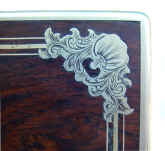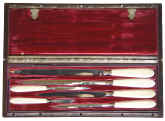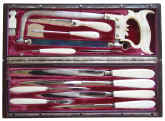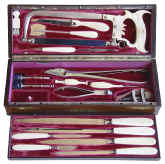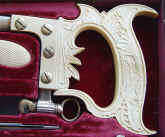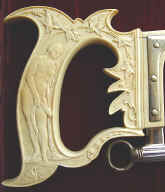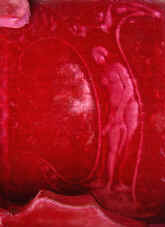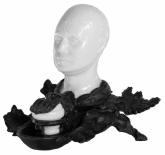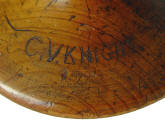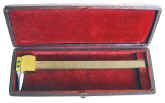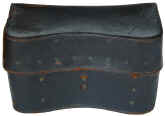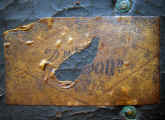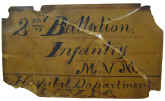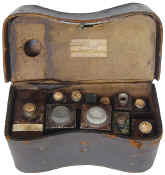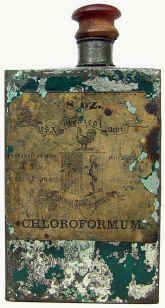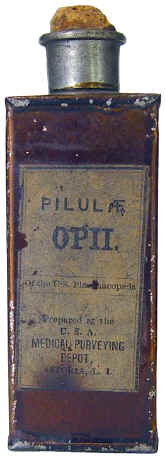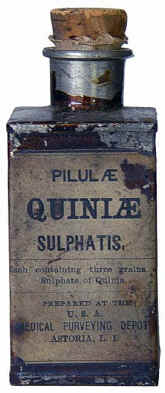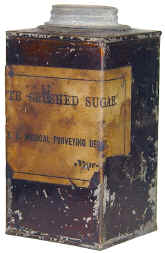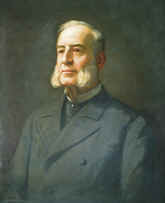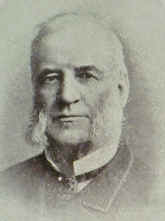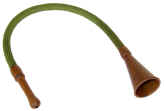| 50. An exceptionally fine 1860s Snowden & Brother, Philadelphia, exhibition surgical set. Note the iconography of the capital saw grip: the dexter side reveals a standing Venus, while the sinister is carved with a sea monster. The opposing imagery may be a reference to the conflict between the Union and the Confederacy during the American Civil War. The German silver lid cartouche incorporates a superb patriotic eagle and is engraved : I. E. Cohn / Surgeon. Isidore Elkan Cohn, M.D. (1851-1916) graduated from the Cooper Medical College, San Francisco, in 1881, and died in Berkeley, California. This is considered to be the best quality American antique surgical set known to exist, and it may have been made for the 1864 Sanitary Fair held in Philadelphia. Snowden & Brother was in business from 1858 to 1872, as listed in Edmonson, p. 264. SOLD | |
|
51. A c. 1860s antique George Washington phrenology bust inkwell. The ink reservoir head of President Washington and the pen dipping cup are opal glass (milk glass). The stand is cast iron that has been painted gold. Washington's idealized head carries phrenological divisions, each being numbered or labeled. The base is replete with symbolism: oak leaves indicate fortitude and strength; ivy leaves signify fidelity and tenacity; laurel leaves represent martial victory and success. The leaves to the sides are shaped to form a cradle for holding pens. The top of the pen cup lid is decorated with an American eagle within a Federal shield, while the underside reads: SEE WASHINGTON MANUAL BY // JOHN HECKER, / N.Y. The front of the glass cup is lettered: WASHINGTON MANUAL. The 1866 manual was a guide to understanding the Washington phrenology bust. United States Patent 13,902 for a self-feeding fountain inkstand used here was granted on 11 December 1855 to Charles T. Close, of New York, New York. The Washington Manual inkstand is 6.5" tall. POR
|
|
| 52. A 19th century antique monaural stethoscope turned from cedar. The face of the earplate is marked MAW, a London maker. The top of the earplate is scratch-engraved C.V. KNIGHT, the apparent original owner. The antique stethoscope is a Fergusson's model according to Maw catalogues of the 19th century. $750 | |
| 53. A brass and steel c. 1860 antique aesthesiometer engraved upon the ruler: J.F. Pratt, 420 Oxford St., W. The surgical instrument maker Joseph F. Pratt was at this London location from c. 1855 to c. 1880. An aesthesiometer is used to test skin tactile sensitivity. This type of aesthesiometer was designed in 1858 by Sir Edward Henry Sieveking (1816-1904), physician to Queen Victoria and Edward VII. The antique neurological diagnostic instrument is housed in its original case. $2,250 |
|
| 54. A fine paraboloid dome style antique ear trumpet by Arnold & Sons, London. $950 |  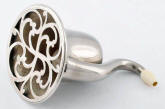 |
| 55. An American Civil War date Collidge U.S. Army field surgeon's companion put-up by George T. Brown, Apothecaries, Boston. The Medical and Surgical History of the War of the Rebellion gives a description and illustration of this Collidge field companion, which was introduced in early 1863 and designed by Medical Inspector R.H. Collidge, U.S. Army. Of special note is the chloroform tin which has a label bearing the arms of the U.S. Army Medical Department and which is dated 1863. SOLD |
|
| 56. A oil on canvas posthumous portrait of Austin Flint, Sr., M.D. (1812-1886), a 19th century pioneer in American cardiology and gauged to be the American Laennec by Dr. Samuel D. Gross. Dr. Flint had a hand in founding two medical schools...the Buffalo Medical College (now SUNY Buffalo) and Bellevue Hospital and Medical School (now NYU). He also taught in Chicago, Louisville, and New Orleans. Flint served three years as president of the New York Academy of Medicine and, in 1883, he was elected president of the American Medical Association. He wrote the first American book on diseases of the heart: A Practical Treatise on the Diagnosis, Pathology and Treatment of Diseases of the Heart (1859). For a synopsis of Dr. Austin Flint, Sr.'s life, please see this link. On the importance of Flint as a physical diagnostician, please see this link. The depiction of Dr. Austin Flint, Sr., is by the noted portraitist George Rufus Boynton (1856-1945). The artist has signed the painting on the front in the lower left corner. This portrayal of Dr. Flint was presented to the New York Academy of Medicine in January of 1901 by ...Dr. E.G. Janeway on behalf of himself and 14 other fellows of the academy, who were donors of the portrait. Boston Medical and Surgical Journal, Vol. CXLIV, No. 4. (1901). It was Dr. Edward Janeway who had lamented that the academy lacked a portrait of Dr. Flint and instigated the Boynton commission. Boynton used an 1880s photograph of Dr. Flint as the model for the painting. Note that the paisley pattern in the cravat and the stickpin are identical in both the oil and the photograph. SOLD | |
| 57. A rare c. 1860 antique flexible monaural stethoscope. The fittings are hard rubber and the tube is covered in a green woven fabric. This a true antique stethoscope and not a hearing aid. An identical flexible stethoscope is illustrated in 19th century Shepard & Dudley catalogues. The overall length is 17". $950 |
|



